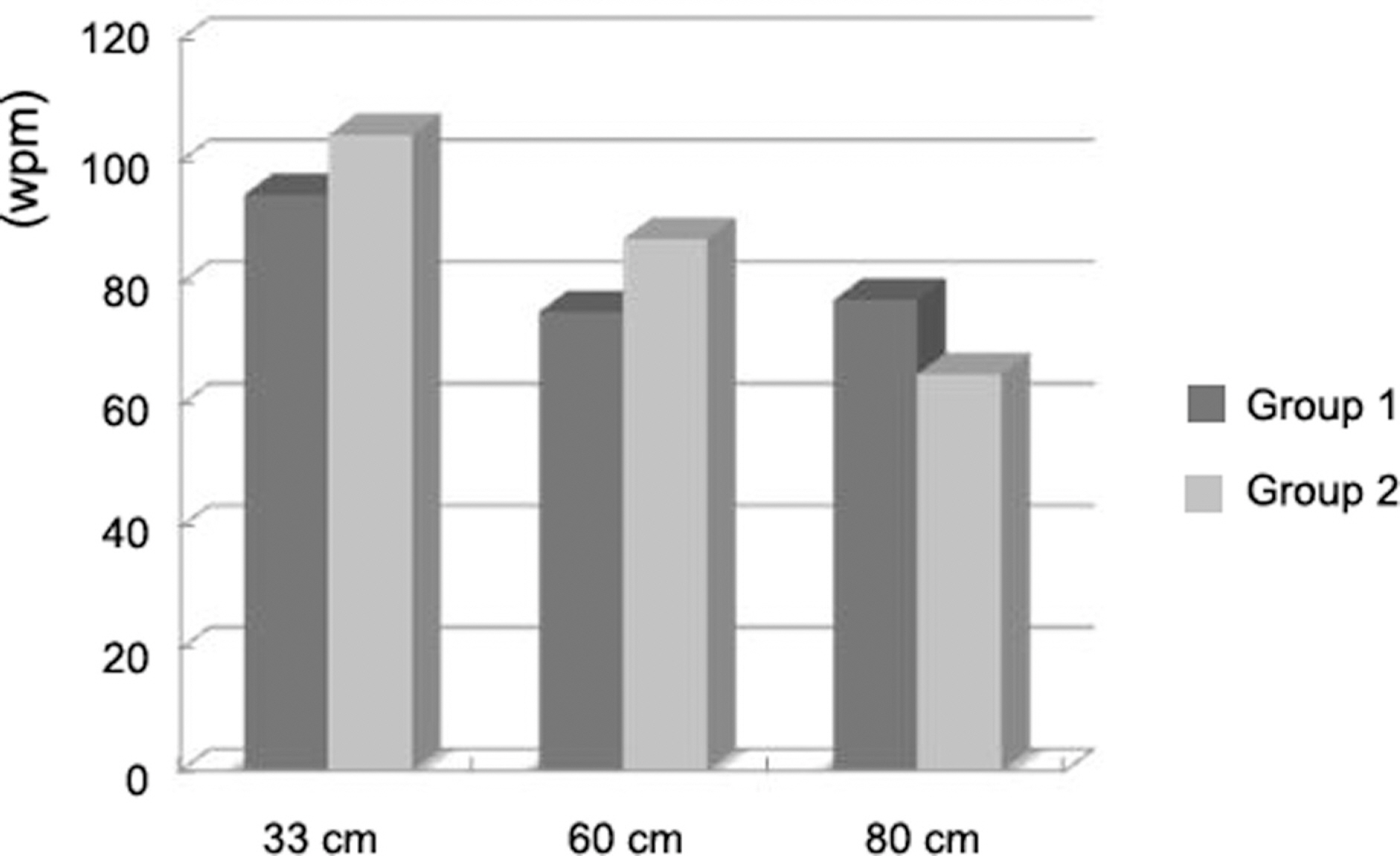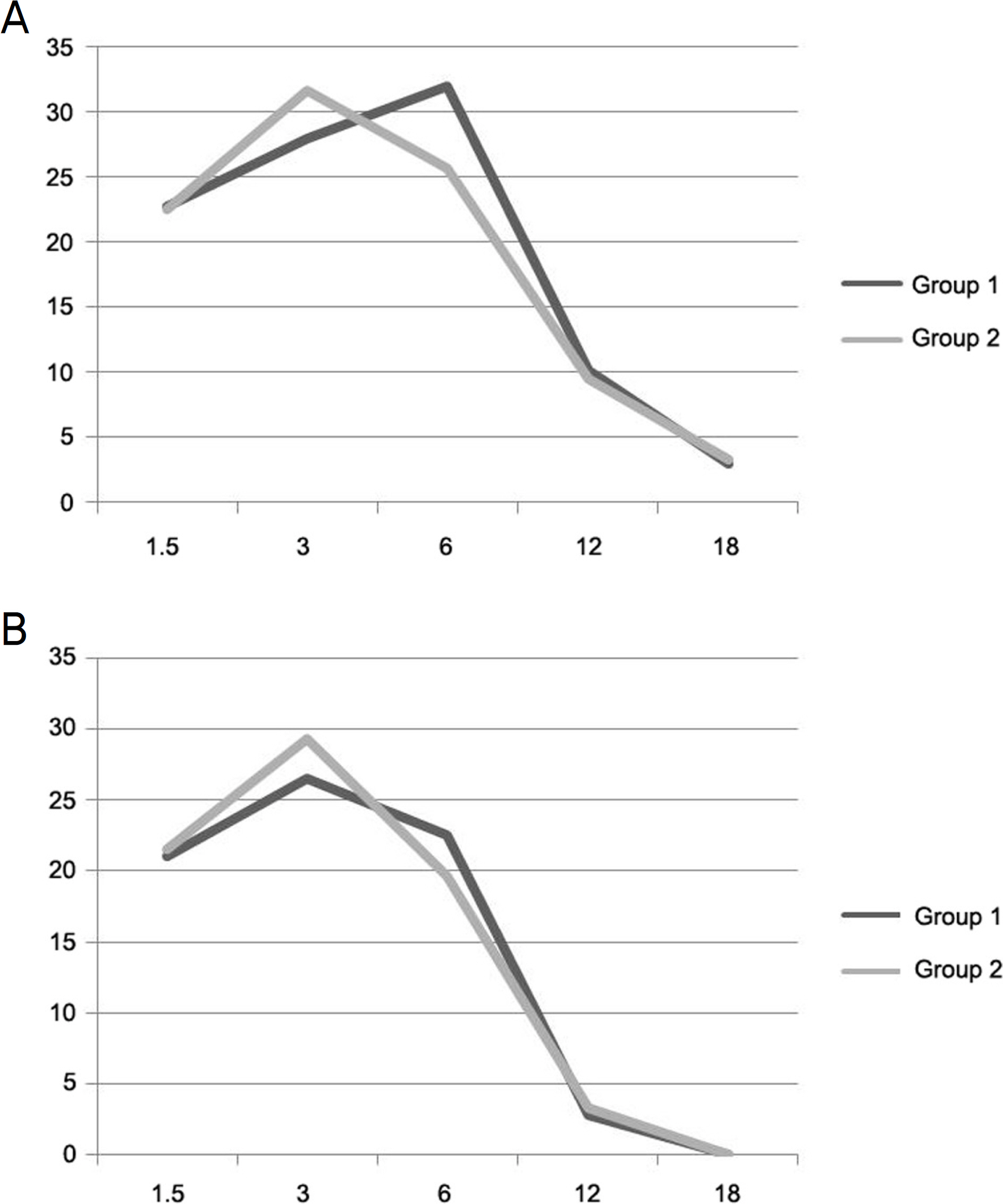J Korean Ophthalmol Soc.
2009 Nov;50(11):1632-1638.
Combined Implantation of Monofocal and Multifocal Intraocular Lenses in Senile Cataract Surgery
- Affiliations
-
- 1The Institute of Vision Research, Department of Ophthalmology, Yonsei University College of Medicine, Seoul, Korea. tikim@yumc.yonsei.ac.kr
Abstract
- PURPOSE
To assess binocular visual outcomes in patients who were implanted with a monofocal IOL (intraocular lens) in one eye and a multifocal IOL in the contralateral eye or with a bilateral multifocal IOL.
METHODS
This study enrolled 15 patients (30 eyes) implanted with a monofocal IOL in one eye and a multifocal IOL in the contralateral eye (5 patients, group 1) or with a bilateral multifocal IOL (10 patients, group 2). Binocular visual acuity (uncorrected/best distance corrected near, intermediate, and distance vision), binocular uncorrected reading speed, and contrast sensitivity were assessed at 6 months following the last implantation. Patient's quality of life (overall satisfaction, halos and glare presence, and spectacle dependence) was also assessed using a questionnaire at 6 months postoperatively.
RESULTS
There was significant difference in the uncorrected and corrected near visual acuity between the 2 groups in the mesopic condition. There was no significant difference in visual acuity, reading speed and contrast sensitivity in other conditions between the 2 groups. Spectacle dependence rate was 60% in group 1 and 20% in group 2. The glare symptom was present in 60% of patients in both groups and the halo symptom was present in 3 out of 10 patients in group 2. Overall satisfaction score was not significantly different between the groups.
CONCLUSIONS
The combined implantation of a monofocal and a multifocal lens revealed similar visual outcomes compared to bilateral multifocal IOL implantation except for near vision. In addition, the results showed similar patient satisfaction in both groups.
MeSH Terms
Figure
Reference
-
References
1. Lane SS, Morris M, Nordan L, et al. Multifocal intraocular lenses. Ophthalmol Clin North Am. 2006; 19:89–105.2. Hutz WW, Eckhardt HB, Rohrig B, Grolmus R. Reading ability with 3 multifocal intraocular lens models. J Cataract Refract Surg. 2006; 32:2015–21.3. Kohnen T, Allen D, Boureau C, et al. European multicenter study of the AcrySof ReSTOR apodized diffractive intraocular lens. Ophthalmology. 2006; 113:578–84.
Article4. Blaylock JF, Si Z, Vickers C. Visual and refractive status at different focal distances after implantation of the ReSTOR multifocal intraocular lens. J Cataract Refract Surg. 2006; 32:1464–73.
Article5. Chiam PJ, Chan JH, Aggarwal RK, Kasaby S. ReSTOR intraocular lens implantation in cataract surgery: quality of vision. J Cataract Refract Surg. 2006; 32:1459–63.
Article6. Sallet G. Refractive outcome after bilateral implantation of an apodized diffractive intraocular lens. Bull Soc Belge Ophtalmol. 2006; 299:67–73.7. Souza CE, Muccioli C, Soriano ES, et al. Visual performance of AcrySof ReSTOR apodized diffractive IOL: a prospective comparative trial. Am J Ophthalmol. 2006; 141:827–32.
Article8. Cumming JS, Colvard DM, Dell SJ, et al. Clinical evaluation of the Crystalens AT-45 accommodating intraocular lens: results of the U.S. Food and Drug Administration clinical trial. J Cataract Refract Surg. 2006; 32:812–25.9. Gunenc U, Celik L. Long-term experience with mixing and matching refractive Array and diffractive CeeOn multifocal intraocular lenses. J Refract Surg. 2008; 24:233–42.
Article10. Goes FJ. Visual results following implantation of a refractive multi-focal IOL in one eye and a diffractive multifocal IOL in the contralateral eye. J Refract Surg. 2008; 24:300–5.
Article11. Sen HN, Sarikkola AU, Uusitalo RJ, Laatikainen L. Quality of vision after AMO Array multifocal intraocular lens implantation. J Cataract Refract Surg. 2004; 30:2483–93.
Article12. Steinert RF, Post CT Jr, Brint SF, et al. A prospective, randomized, double-masked comparison of a zonal-progressive multifocal intraocular lens and a monofocal intraocular lens. Ophthalmology. 1992; 99:853–60.
Article13. Percival SP, Setty SS. Prospectively randomized trial comparing the pseudoaccommodation of the AMO Array multifocal lens and a monofocal lens. J Cataract Refract Surg. 1993; 19:26–31.
Article14. Jacobi PC, Konen W. Effect of age and astigmatism on the AMO Array multifocal intraocular lens. J Cataract Refract Surg. 1995; 21:556–61.
Article15. Javitt JC, Wang F, Trentacost DJ, et al. Outcomes of cataract extraction with multifocal intraocular lens implantation: functional status and quality of life. Ophthalmology. 1997; 104:589–99.16. Javitt JC, Steinert RF. Cataract extraction with multifocal intraocular lens implantation: a multinational clinical trial evaluating clinical, functional, and quality-of-life outcomes. Ophthalmology. 2000; 107:2040–8.17. Jacobi PC, Dietlein TS, Luke C, Jacobi FK. Multifocal intraocular lens implantation in prepresbyopic patients with unilateral cataract. Ophthalmology. 2002; 109:680–6.
Article18. Cillino S, Casuccio A, Di Pace F, et al. One-year outcomes with new- generation multifocal intraocular lenses. Ophthalmology. 2008; 115:1508–16.19. Mayer S, Böhm T, Häberle H, et al. Combined implantation of monofocal and multifocal intraocular lenses for presbyopia correction in cataract patients. Klin Monatsbl Augenheilkd. 2008; 225:812–7.20. Vingolo EM, Grenga P, Iacobelli L, Grenga R. Visual acuity and contrast sensitivity: AcrySof ReSTOR apodized diffractive versus AcrySof SA60AT monofocal intraocular lenses. J Cataract Refract Surg. 2007; 33:1244–7.
Article21. Lee JM, Seo KY, Kim EK. Comparison of optical aberrations and contrast sensitivity between monofocal and multifocal intraocular lens. J Korean Ophthalmol Soc. 2002; 43:1882–6.22. Song MJ, Lee MK, Park BI. A Clinical study of 3M multifocal intraocular lens implant. J Korean Ophthalmol Soc. 1991; 32:234–40.23. Monte's-Mico' R, Espana E, Bueno I, et al. Visual performance with multifocal intraocular lenses mesopic contrast sensitivity under distance and near conditions. Ophthalmology. 2004; 111:85–96.24. Schmitz S, Dick HB, Krummenauer F, et al. Contrast sensitivity and glare disability by halogen light after monofocal and multifocal lens implantation. Br J Ophthalmol. 2000; 84:1109–12.
Article25. Allen ED, Burton RL, Webber SK, et al. Comparison of a diffractive bifocal and a monofocal intraocular lens. J Cataract Refract Surg. 1996; 22:446–51.
Article26. Rossetti L, Carraro F, Rovati M, Orzalesi N. Performance of diffractive multifocal intraocular lenses in extracapsular cataract surgery. J Cataract Refract Surg. 1994; 20:124–8.
Article27. Kamlesh , Dadeya S, Kaushik S. Contrast sensitivity and depth of focus with aspheric multifocal versus conventional monofocal intraocular lens. Can J Ophthalmol. 2001; 36:197–201.
Article28. Heo JY, KIm YH, Joo CK. Clinical results of AMO ARRAY multi-focal intraocular lens. J Korean Ophthalmol Soc. 1999; 40:978–86.29. Leyland , Langan L, Goolfee F, et al. Prospective randomised double-masked trial of bilateral multifocal, bifocal or monofocal intraocular lenses. Eye. 2002; 16:481–90.
Article30. Choi HS, Lim SJ, Kim HB. Clinical results of unilateral implantation of AMO Array multifocal intraocular lens. J Korean Ophthalmol Soc. 2001; 42:702–8.
- Full Text Links
- Actions
-
Cited
- CITED
-
- Close
- Share
- Similar articles
-
- Comparison of Optical Aberrations and Contrast Sensitivity between Monofocal and Multifocal Intraocular Lens
- Clinical outcomes of currently available multifocal intraocular lenses
- Clinical Results of Unilateral Implantation of AMO Array Multifocal Intraocular Lens
- The change of visual acuity and visual field by diminished illumination in eyes with multifocal intraocular lens
- Comparison of Higher-Order Aberration and Contrast Sensitivity in Monofocal and Multifocal Intraocular Lenses




